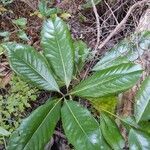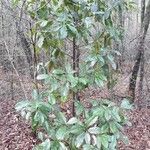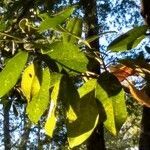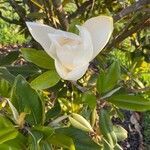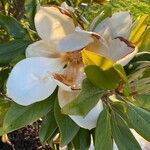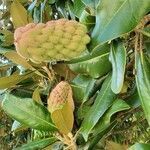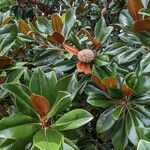Trees, to 30 m tall but usually shorter when cultivated. Bark pale brown to gray, thinly scaly fissured. Twigs, vegetative buds, petioles, and leaf blade abaxial surfaces densely brown to grayish brown shortly tomentose but abaxial surface of young leaf blades glabrous. Twigs thick and strong. Petiole 1.5-4 cm, deeply furrowed, without a stipular scar; leaf blade elliptic, oblong-elliptic, or obovate-oblong, 10-20 × 4-7(-10) cm, thickly leathery, adaxially deep green and glossy, secondary veins 8-10 on each side of midvein, base cuneate, apex obtuse to shortly mucronate. Flowers 15-20 cm in diam., fragrant. Tepals 9-12, white, obovate, 6-10 × 5-7 cm, thickly fleshy. Stamens ca. 2 cm; filaments purple, flat; connective exserted and forming a mucro; anthers introrse. Gynoecium ellipsoid, densely long tomentose; carpels ovoid, 1-1.5 cm; styles reclinate. Fruit terete to ovoid, 7-10 × 4-5 cm, densely brown to pale grayish yellow tomentose; mature carpels abaxially rounded, dehiscing along dorsal sutures, apex long beaked. Seeds ovoid, ca. 1.4 × 0.6 cm; testa red. Fl. May-Jun, fr. Sep-Oct. 2n = 114.
Handsome tree to 30 m; winter terminal bud 1–2.5 cm, evidently hairy; lvs scattered or somewhat clustered toward the ends of the twigs, leathery, evergreen, elliptic, 12–25 cm, a third or half as wide, acute to obtuse, basally acute to rounded-obtuse, the lower surface conspicuously rusty with a ± persistent, thin, villous tomentum; fls fragrant, creamy-white, cup-shaped, ca 10 cm thick; pet 6–12, obovate or spatulate, broadly rounded distally, concave, 7–13 cm; fr cone ellipsoid, 6–10 cm, the follicles woolly-villous; 2n=ca 114. Rich woods and moist bottomlands; coastal plain from se. Va. to Fla. and Tex. Apr.–June.
An evergreen tree. It is a broad cone shape. It grows 25 m high. The trunk is 60-90 cm across. The bark is dark grey and smooth. It becomes furrowed and scaly. The leaves are deep glossy green. They are 13-20 cm long by 5-7.5 cm wide. They are stiff and leathery. They are often a rusty furry colour underneath. The flowers are large and creamy white. They are 15-20 cm wide. They are saucer shaped. They have a scent. The fruit are woody and have bright red seeds. Many cultivated varieties exist.
